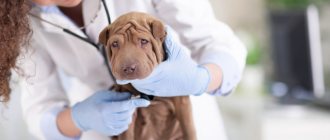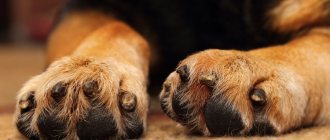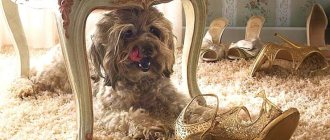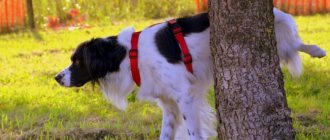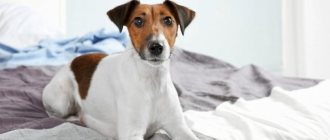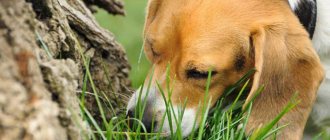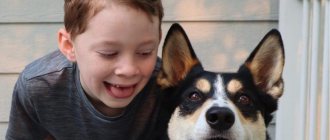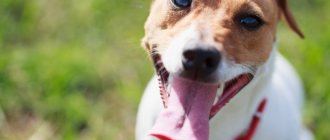In people, nail biting is considered a bad habit that is mental in nature and requires correction. Usually, for this it is recommended to visit a psychologist, who will find out the roots of the problem. But why a dog bites its claws, and what this behavior may be associated with, few people know, except perhaps veterinarians. Indeed, should the owner worry if his four-legged pet begins to regularly damage his own claws? And when can you not do without professional help?
Illness, discomfort or anxiety
It’s not for nothing that dogs are called man’s best friends - they don’t just live side by side with people, save them from loneliness, make them happy, and serve faithfully. These pets literally adopt human habits; they can experience joy, discomfort, melancholy or anxiety. And if the dog suddenly begins to bite its claws, it is worth observing its behavior. Perhaps this is an alarm bell - a sign of malaise or suffering from loneliness.
Allergy
If your dog's paws are itchy, it could be due to an allergy. Allergies are common and can be caused by the environment, food, or an irritant that comes into contact with your dog's skin.
Redness, dark pigmentation, or brown spots on the paws from constant licking may be signs of an allergy. Washing or drying your dog's paws after going outside will reduce the number of allergens on your dog's skin.
Topical hydrocortisone creams or sprays sold for dogs can temporarily relieve the itching, but more intense licking requires systemic treatment (prescription medications that affect the entire body).
Main reasons
There are several reasons why a dog may begin to constantly chew and bite its back legs. Often this problem is caused by physiological factors and non-compliance with maintenance rules:
- poor-quality care - the owner does not clean the dog after walks, does not trim its nails regularly;
- contact with reagents that are sprinkled on ice in winter;
- unbalanced diet, lack of sufficient protein, vitamins and minerals in the diet;
- mechanical damage to the skin, abrasions and splinters.
These difficulties can be easily resolved on your own, without visiting a veterinary clinic. It is enough to monitor the pet’s condition and conduct regular examinations. The dog may begin to actively lick and chew its paws due to illness. A similar symptom is characteristic of the following diseases:
Tags
Why does a dog gnaw Why a dog gnaws dog owners is their dog gnaws causing a dog to gnaw which dog can his dog gnaws keeping a dog. cause a dog pain a dog or can gnaw on claws will gnaw on everything can gnaw on a claw begins to gnaw on a claw as causes the main reasons can cases cause excessive and cause a dog not become a cause Sometimes the cause of the strange will establish the reason for this
article constantly content of your vitamins neurosis pet share similar more often the beginning is the owner in comments and the site published
Paw care after a walk
Proper care of your pet after a walk is a basic method of prevention to prevent the dog from gnawing its paws. Allows you to avoid complications from mechanical damage (wounds, abrasions, splinters), infections and the consequences of contact with reagents in winter.
After each visit to the street, paws should be washed with clean running water, and if necessary, use a special shampoo for dogs. Recently, paw washers have become very popular - small jars with brushes inside that are easy to use for cleaning dirt for any breed. After hygiene procedures, carefully examine the paw pads and fur. There should be no traces of dirt, blood or mechanical objects.
Treatment and treatment at home
In the early stages, when there is no severe tissue damage in the area of the pads, treatment can be carried out at home. The main rule is high-quality care for your pet’s paws, as well as timely treatment when gnawing. Algorithm of actions:
- Carefully examine the area that the dog is licking (pads, fur on the bend of the limb, fingers).
- Remove any visible dirt with a cotton pad soaked in clean water.
- Trim off excess hair and shorten the length of nails if possible.
- Treat the skin with any antiseptic solution (Miramistin, Chlorhexidine, Furacilin).
- If there is bleeding, apply a cotton pad with hydrogen peroxide and secure it with a special adhesive bandage. It is recommended to additionally wear a muzzle or an Elizabethan collar.
It is recommended to carry out treatment after each walk, at least 2 times a day. If there are no visible improvements within 2-3 days, then contact a veterinary clinic.
Why does a dog bite its claws: psychological and physical reasons
Pets are in many ways similar to their owners, at least they also experience joy, discomfort, pain or boredom. If a dog chews its claws, the owner should take a closer look at his behavior, perhaps there is a bigger picture behind the strange habit. Perhaps the pet is sick or suffering from loneliness.
The first reason that needs to be ruled out is kinks and cracks in the claws . Carefully examine each toe on the front paws. Some four-legged animals like to dig and may stumble upon roots or hard debris buried in the ground. When a dog digs, it is in high spirits and may not immediately feel discomfort. If your dog bites its nails after a walk, do the following:
What can be done in such a situation
After discovering a problem, every owner wants to know what to do if their dog bites its nails. First of all, it is necessary to eliminate the cause of this behavior, if it is obvious. To do this, you first need to check the length and condition of the claws. In most cases, it is enough to simply trim the nails with a special nail clipper for dogs. At the same time, care must be taken not to shorten them in such a way that a nerve or vessel will be affected. It is enough to trim them at the level of the fingertip. If the edges are too sharp, they need to be carefully filed.
Dirty paws need to be washed thoroughly, removing any dirt, sand or gravel that has accumulated between the toes. With high-quality regular washing, the risk of inflammation from street pollution becomes much less. The risk of skin allergies is also reduced.
If your dog's claws grow too long due to an unhealthy lifestyle, increase the time and frequency of his exercise, and drive the animal on asphalt and hard ground more often and for longer. Entertain a bored dog, buy him toys and be around him more. For chronic stress, determine the cause - it could be noise, a small child who is tormenting the dog, an uncomfortable place to sleep, a rude attitude, poor health, and much more.
If a dog bites its claws due to health problems, there can only be one way out - a visit to the veterinary clinic. Only a doctor can accurately diagnose and prescribe the necessary treatment.
Watch the behavior of your four-legged friend, it can tell a lot about his mood and well-being.
How to distinguish licking from gnawing?
A paw in a dog's mouth is not a reason to go to the vet. Some clean breeds groom themselves this way. The desire to lick the paws, pads, and fur between them sometimes becomes obsessive and the animal spends a long time doing this activity. This is not a bad habit or a deviation.
To save the dog from the need to lick, the owner should wash the animal's paws more thoroughly after a walk. After licking, no traumatic effects remain on the animal’s limbs. A dog can be easily distracted by offering a treat.
How to recognize the problem?
Caring for your paws is a natural hygiene procedure for any dog. A deviation is considered if the desire to lick the limbs becomes obsessive, the animal often gnaws the pads for a long time. To detect the problem, you should inspect your dog's paws regularly. They should be free of persistent dirt, signs of injury and other mechanical damage. The following signs are unacceptable:
- presence of blood;
- inflamed and weeping areas of the skin;
- dry crusts on the pads;
- traces of alopecia (hair loss);
- change in dog behavior;
- refusal of food, games.
Be sure to pay attention to any deviations in your pet’s usual behavior. You should consult a doctor if your dog becomes aggressive or apathetic (when he chews), refuses food and even his favorite treats. The problem can be especially dangerous if the pet begins to growl and grin, and does not allow him to approach him during the next licking of his paws.
Inspection of a dog's paws should be done carefully. Even the slightest touch of the paws can be painful and uncomfortable for the dog. You need to be careful when touching the paws of older pets - the problem may arise due to age-related joint diseases.
Why does a dog bite its claws?
In people, nail biting is considered a bad habit that is mental in nature and requires correction. Usually, for this it is recommended to visit a psychologist, who will find out the roots of the problem. But why a dog bites its claws, and what this behavior may be associated with, few people know, except perhaps veterinarians. Indeed, should the owner worry if his four-legged pet begins to regularly damage his own claws? And when can you not do without professional help?
Disease or bad habit?
It is not for nothing that psychiatrists introduced a special definition into medical practice - onychophagia. This term implies a mental disorder (!), which is expressed in an uncontrollable desire to bite the nail plate.
This disorder develops gradually, moving from a seemingly harmless habit.
Surveys have shown that almost a third of children of primary school age are prone to biting their nails, and this habit is much more common among male children.
Then the incidence only increases, since almost half of children bite their fingers during adolescence. This may be due to the increasing psychological stress.
That is, a bad habit cannot be left alone with a child, hoping that he will outgrow it. On the contrary, there is a risk that the problem will simply develop into a mental disorder, which cannot be overcome without the help of doctors.
Therefore, you need to find the provoking factor and, if possible, get rid of it.
Bites claws when stressed
Such behavior is not always caused by illness and physical discomfort. It is often due to the fact that the dog experiences stress - after a fright, during longing for the owner, when changing place of residence and other situations that knock the pet out of its usual rut. Puppies are more active than their adult counterparts and require regular exercise. But although older dogs are more balanced, they can also become bored.
If a pet does not receive proper attention, does not have the opportunity to throw out excess energy, and rarely goes outside, then it is susceptible to the development of a mental disorder, obsessive neurosis - compulsive syndrome. If a puppy begins to bite its claws out of boredom, later the older dog may resume this habit. The pet can do this during times of stress, fear and other experiences, finding calm in the activity.
A healthy, adult dog, having seen off the household, goes to have a meal and lies down to rest. But against the background of compulsive disorder, the animal, when alone, shows anxiety. The pet can gnaw its claws, chew or frantically lick its own limbs - the fur on them is constantly wet, sparse, bald spots and irritations appear.
In addition to mental disorders, the disorder causes a number of quite tangible physical illnesses. Damaged nail plates, wounded skin on the fingers - all this is accompanied by severe pain, due to which the dog is unable to concentrate, does not listen, or even loses interest in walking.
Often dogs unintentionally injure their limbs by catching them with their teeth. In this case, discomfort and pain are not the main problem. Pathogenic bacteria penetrate open wounds.
Most often, the forelimbs of pets are affected by lick granuloma. With this disease, the damaged area turns red, but in a short period it turns into an open, large wound. And if the dog continues to lick the limb, the muscle tissue begins to die until the bone is exposed. This pathology requires proper treatment; the veterinarian prescribes drugs for topical application and agents with a calming effect.
Experts warn that psychological disorders require complex therapy, that is, no matter how much you treat a dog’s damaged paw, it will continue to experience stress, lick and chew the limb, aggravating its own condition.
How to stop a puppy from biting: ov
The easiest way is to wean a kitten from using its teeth. Kids are receptive: what they learned in childhood they will carry with them throughout their lives.
If a dog bites your hands before the age of six months, use the methods listed below.
Punish with hand
The statement that punishment can only be carried out with objects, because... the kitten will be afraid of hands - nonsense. The parent dog licks the puppies, chews their food and, with the same mouth, scolds the presumptuous mischief-makers. There has never been a single puppy that was afraid of its mother's mouth.
How to do it is another matter. Hitting is prohibited. You can stop a little prankster from grabbing hands:
- clicking the nose or ears;
- spanking (lightly!) on the rump: you can’t hit the butt, dogs don’t have gluteal muscles, and there are kidneys in the area of the seat;
- sharply grabbing and pinching with your palm, imitating a bite.
When your baby bites your arms or legs, you should not break down. This is not how you wean your pet. The punishment is as painless as possible - pinching and spanking are symbolic, they humiliate more than they bring physical discomfort.
Calm down
The playing kitten is cut off:
- sending to the place;
- giving commands of prohibition (“No”, “Fu”) or restraint (“Stand”, “Sit”, “Lie down”);
- when pushing out of the room, they make a prohibiting gesture and, walking towards the pet, push him into another room;
- ignoring - they don’t talk to the kitten, don’t look him in the eye, turn their side or back to him.
Using the same methods, you can wean your dog from jumping when meeting people.
Infections, fungal infections and other ailments
When something hurts or causes discomfort, only one desire arises - to stop it by any means. A person takes pills or goes to the doctor, a dog licks or chews the “causal” area.
The allergy causes itching in soft areas of the skin, including between the fingers. Since the dog cannot scratch its paw with its other paw, it uses its teeth. Usually, the four-legged itch very much and often, clearly making it clear that a specific place is bothering him.
Note! A dog may consciously bite its claws if it has severe vitamin deficiency.
Infectious lesion - on a walk, the pet can pick up a splinter and behave absolutely normally for several days. The infection process may not appear for several more days, at a time when the dog is already experiencing discomfort. In this case, the pet will lick its paws and claws, trying to soothe the pain. Obvious swelling, suppuration, abscess - these are already consequences.
Note! After walking, blades of grass, small branches or rolled snow may get stuck in the fur between the fingers and the dog will chew out the foreign object.
Fungal infection - leads to diseases of the claws , their separation and severe itching in the affected area. Affected claws change color (lighten), sometimes they have a sweetish smell.
Symmetrical lupoid or lupus onychodystrophy (SLO) is a disease characteristic of large dogs. The causes of the disease have not yet been established, but it is usually classified as autoimmune. The disease is expressed by the sequential rejection of all nail plates from the claw bed (including on the dewclaws). When the first toe is affected, many owners and veterinarians confuse TLS with injury. Claws that are not completely peeled off cause pain when walking and the dog literally tears off the nail plates with his teeth.
Folk recipes
Well-established traditional methods of getting rid of such a bad habit are not always considered humane. Many mothers refuse to use such methods, considering them too harsh (“I can’t mock the baby”). However, they should still be listed.
- Perhaps the most common and at the same time controversial method is to smear children's fingers with hot pepper, mustard and similar natural bitterness. It is believed that after tasting such an unpleasant spicy seasoning once or several times, a child will then stop biting his nail plates.
- The older generation often advises treating nails with green paint, since such an unpleasant appearance can repel a child so much that he will stop biting his nails. If, nevertheless, the fingers end up in the mouth, one’s own green lips, seen later in the mirror, can turn the child away from the bad habit.
Such methods are controversial, however, judging by the reviews, they can still work, especially if the child is between two and four years old. Such methods will definitely not work on older children.
Clinical picture
On the affected areas of the paws, there is most often a papular-pustular rash (small red pimples and pustules), erythema (redness) of the skin, peeling, there may be small scratches and hairless areas. Sometimes single or multiple “nodules” can form in the interdigital space - dense painful formations, which after some time open with the release of pus. Lesions can occur on one limb or on several at once. The skin of the interdigital spaces may be affected both from the side of the pads and from the opposite side.
Ringworm
Ringworm is a fungal infection that spreads easily through contact with contaminated soil or animals. It is usually found on the paws, as well as the head, ears and limbs of dogs.
Hair loss and redness of the skin may occur, but some animals may have ringworm and not show any signs.
Topical creams, shampoos, and sauces can be helpful in getting rid of ringworm.
Long-haired animals may need to have their hair shaved to prevent re-infestation. This should only be done with pet clippers and you should use a guide comb to avoid pressing too close to the skin.
How to help a dog
Often, owners who ask questions: “Why does a dog chew its paws, what to do in such cases?” explain their dog’s behavior as a habit or character trait, so they are in no hurry to take their pet to the veterinarian. Or, which is also not a good idea, wanting to help a dog get rid of itching in a certain area of the skin, they use “human” drugs. Self-medication is dangerous and can cause a lot of side effects. Remember that negligent attitude towards the health of your four-legged pet is fraught with serious consequences and complications.
Without wasting time, take the dog to a veterinary clinic, where the doctor will examine the animal, conduct the necessary clinical tests, and take scrapings to determine the allergic reaction and the presence of parasites.
There is no single treatment for when a dog often chews its paws. Therapy is prescribed after diagnosis is established.
Allergies may be indicated by redness, scratching and sores on the abdomen, groin, limbs, tail, warm and slightly moist skin in inflamed areas. Treatment includes the use of antihistamines, treating wounds with a disinfectant solution, eliminating contact allergens, and a special balanced diet.
If the cause of itching is insects (fleas, ticks), the use of antiparasitic agents is indicated - shampoos, sprays, drops on the withers and collars.
In severe cases, hormonal drugs are prescribed for symptomatic treatment.
Antibiotics are indicated for infections that have entered the pet’s body through wounds and scratches and caused inflammation.
Briefly about the main thing
- Dogs lick their back and front paws for hygienic purposes. In this way they get rid of dirt and objects left between the pads after walks.
- If the procedure becomes intrusive, severe scratching, redness, signs of hair loss and bruising appear on the limbs, you should contact a veterinarian.
- The main reasons why a dog chews its paws are neurosis, allergies, mechanical damage to the pads, infection, and exposure to reagents.
- For prevention, you should wash your pet after every walk, remove excess hair and trim its nails. In winter, wear boots or use protective wax when walking.
Have you ever experienced your dog chewing his paws? Share in the comments what to do in such a situation, how to help your pet.
Did you like the article? Share it with your friends on social media. networks. This will help them get useful information and support our project.
Diagnostics
At an appointment with a veterinarian, an external examination takes place. The veterinarian examines the general condition of the animal, the dog’s oral cavity, and carefully examines the wounds. If matted fur or abnormal nail growth occurs, the animal is sent to a groomer to correct the problems.
If there are no visible injuries, but the animal continues to bite its paws, an in-depth examination is carried out. The doctor takes:
- scrapings to determine allergic reactions or parasites;
- blood chemistry;
- cal.
The question of treatment will arise after receiving the results.
Additional Research
To understand why a dog scratches its paws, the doctor must not only carefully examine the dog and interview the owner, but also conduct a number of additional studies.
So, the doctor must take fingerprint smears from the skin to understand whether there is a secondary inflammation and what it is associated with (bacteria or fungi).
Multiple scrapings (diagnosis of demodicosis, sarcaptosis) and hair plucking (diagnosis of demodicosis in the interdigital spaces) should also be performed to confirm or exclude parasites. It is important to remember that if the doctor does not find sarcoptes scabies mites in the scrapings, but the dog’s symptoms are similar to this disease, then treatment for this parasite will definitely be prescribed!
In addition, a surgeon may be invited to the appointment to assess the functionality of the dog’s musculoskeletal system.
What is the cause of itching?
- Parasites. These are not only fleas that are clearly visible to the naked eye. Itching can be caused by fairly large (up to four millimeters in length), but less noticeable lice, as well as microscopic mites (including ear mites), lice mites. Their appearance affects the condition of the animal’s fur: it becomes dull, becomes thinner, easily becomes matted, and bald patches form in some places. Also, in the presence of parasites, changes in the skin occur. The skin acquires a yellowish-gray tint, becomes rough, begins to peel, and marks appear on it from the teeth of a dog trying to relieve the itching on its own.
- Allergy. It can be caused by food, external natural irritants (pollen, mold), household chemicals (cleaning, detergents, hygiene products), and medications. As a rule, itching due to allergies is accompanied by nasal discharge, sneezing, watery eyes, swelling, and skin rash.
- Fungal diseases. Signs of fungus are the appearance of a small bald patch on the coat, redness of the skin followed by greying, peeling and, of course, itching. The fungus primarily affects the dog's head, neck and paws, but if left untreated it can spread throughout the body.
- Bacterial damage. The most common disease is pyoderma. The main signs besides itching: inflammatory processes on the animal’s skin, the formation of erosions, ulcers, ulcers, and the appearance of a putrid odor. The result is lethargy, apathy, and refusal to eat.
- Hormonal imbalance. If your dog's thyroid gland doesn't produce enough hormones or produces too much cortisol, skin problems can occur. Symptoms of hormonal imbalance are similar to those of an allergic reaction.
- Diseases of internal organs. Itching can be caused by serious problems in their functioning. Common causes are diabetes, kidney or liver failure.
- Dry skin. It is caused by cold winter weather, central heating, and a deficiency of fatty acids in the body. The dog's reaction may be constant scratching and licking.
- Pain. Physical discomfort is another reason for scratching, licking and gnawing. If the dog pays attention to the same place on the body, carefully examine it: perhaps a thorn, splinter or sharp fragment has stuck there. If there is no foreign body, then the cause of this behavior may be bone problems: arthritis, hip dysplasia.
- Stress, anxiety, boredom. Just as a person, during stress, begins to involuntarily bite his lips, bite his nails, or twirl his hair around his finger, so a dog can experience a physical reaction to a psychological disorder. Usually it manifests itself in constant scratching, intense licking, and inappropriate behavior. The cause of stress is often a change in the usual environment, moving, the appearance of a new tenant (relative, child, other animal), or betrayal by the owner. Think about it: is your dog getting enough attention? “Psychological” itching can be caused by banal boredom.
How to help your dog with itching?
Itching is caused by many different factors. The best solution is to visit a veterinarian as soon as possible. He will identify the causes of the problem and prescribe appropriate treatment. Depending on the diagnosis, this may include the following:
- Elimination of parasites. If they are the cause of the itching, the doctor will recommend treating the dog with the most suitable antiparasitic agent. During treatment, do not forget to regularly clean the animal’s sleeping area, vacuum carpets and upholstered furniture. This will reduce the likelihood of re-infection. If you have other animals, they will also need parasite treatment.
- Change of diet. If you are diagnosed with a food allergy, you will need to exclude potential allergens from your pet’s diet: beef, wheat, and other products. Therefore, the doctor will recommend a special hypoallergenic diet for the dog, which is not recommended to be violated.
- Taking medications. The veterinarian can prescribe both tablets and external preparations for topical use. They may contain antibiotics and anti-itch agents.
- Behavioral prevention. Since impulsive reactions can harm your dog, it is necessary to protect the animal from them. Wearing a special collar will help solve the problem. It can be purchased at a veterinary pharmacy or made independently. Sprays with a bitter taste can also help prevent gnawing and biting.
- Fight stress and boredom. If the itching is caused by psychological problems, try to pay more attention to the dog. Make sure that the dog does not suffer from a lack of physical activity and receives enough love and care. Redirect the urge to chew on toys and bones. This activity will help the animal to distract itself and relieve stress.
News about dogs and canines
Treatment
If the veterinarian has identified the cause of this behavior, the irritant must be removed. But the method of treatment directly depends on the specific problem.
Neurosis in a dog
Neurosis is understood as a disorder that provokes asthmatic, hysterical, obsessive manifestations. Symptoms can be extensive, including paw biting.
Neurosis can manifest itself in the form of paw biting
To cure neurosis, it is necessary to eliminate the cause of stress. Every owner probably knows when a dog falls into this state.
- Perhaps the animal is frightened by a walk during which it was injured.
- If an animal has ever been hit by a car, it will be afraid of all vehicles that remind them of the unpleasant incident.
- The animal was offended by someone in the family and now the dog is worried about its life in his presence.
As soon as the cause is established, it is necessary to protect the animal from worries.
- Surround your dog with affection and love.
- Provide her with emotional and physical peace.
- Protect the animal from walking for a while.
- Create a cozy place for your dog where he will feel warm and safe.
- Leave your dog alone for a while so he can rebalance his emotional system.
- At the same time, try to diversify your pet's menu. Add more healthy vitamins and minerals to it.
- Don't deny your dog attention if it demands it. If an animal offers you a game or wants to lie next to you, allow it.
Surround your dog with affection and love
Consequences of the reagent
In winter, a so-called reagent in the form of salt appears on the streets of large cities, which greatly worsens the condition of the skin. Owners of four-legged animals complain that the animals' fingertips are corroded. Some have only a minor rash and burning sensation, while other dogs suffer from severe burns.
First of all, you need to pay attention to preventive measures.
- If the animal is a small and medium-sized dog breed, try to teach it to walk in special dog shoes.
Special boots for dogs
- If you can't train your dog to wear boots, use regular Vaseline. By lubricating your paws before a walk, you can reduce the impact of reagents on the skin.
Vaseline can reduce the impact of reagents on a dog's paws
- Sunscreen spray and emulsion also offer a water-repellent effect. Partially protects paws from chemical compounds.
- Every time after a walk, thoroughly wash your animal's paws with shampoo.
- After this, pat your skin dry and apply a rich moisturizer to the pads. Train the animal to lie still for a while so that the cream is absorbed.
If the dog does become a target for the reagent and its paws are severely corroded, treatment is necessary.
- Paws must be treated with 0.05% Chlorhexidine.
- It is necessary to lubricate with anti-inflammatory ointment Levomekol or Iruxovetin.
- Severe injuries must be bandaged with sterile bandages.
- Before going to bed, wash your animal's paws with chamomile solution.
- Lubricate the paws with vitamins Vittri and Trivit several times a day.
- Ensure that the animal spends more time in a lying position.
Vittry vitamin solution
Fungus
Almost all fungal infections in animals are accompanied by burning and itching. Therefore, scratching the skin of the paw until it bleeds is a normal practice. If the examination reveals a fungus, it is necessary to immediately begin treatment.
- First, give your dog an anti-itch medication so that it does not worsen the condition of the affected area. Stop Itching is a great product.
Suspension Stop-itching
- Buy a protective collar accessory that will prevent the animal from harming itself.
Special protective collar for dogs
- Wounds formed on the skin must be treated with an antiseptic. Miramistin will do.
Miramistin for wound treatment
- At first, keep your pet away from moisture.
- Avoid walking until your paws heal.
- If your pet's paws are sweating, dry them with a hairdryer.
- Ask your veterinarian to prescribe a course of vitamins. They will strengthen the immune system and give the necessary tone.
- Antifungal ointments are prescribed, for example Clotrimazole or Mycozolon.
Antifungal ointment Mikozolon
- Change detergents to Imaverol or Nizoral.
Shampoo Nizoral
- In addition to ointments, veterinarians prescribe tablets and injections. Most often, the choice is made towards Fluconazole. The drug not only fights the fungus, but also helps the immune system by releasing immunostimulants and modulators into it.
Attention! The owner must protect himself. All procedures must be performed with gloves. The animal must be isolated from children and other animals.
An example of fungus on a dog's paw
You should not self-medicate, it leads to disastrous results. A month after treatment, it is necessary to take a biochemical blood test. The study will help assess the general condition of the animal and the effectiveness of the chosen therapy.
Diseases: infectious, fungal and others
Often the dog begins to chew its paws because it is bothered by itching that occurs due to some pathological conditions. Unfortunately, dogs do not have hands, and they have to use their teeth to get rid of itching. Paws may itch due to the following diseases or pathologies:
- allergic reaction;
- severe vitamin deficiency;
- diseases caused by infectious pathogens;
- ailments caused by pathogenic fungi - they affect the nail plate, which begins to delaminate, accompanied by unbearable itching. The claws become lighter in color and may emit a sweetish, nauseating odor;
- symmetrical lupoid or lupus onychodystrophy - a disease that affects representatives of large and giant breeds, is considered an autoimmune disease. As it develops, the nail plates are torn away from the bed.
Nail gnawing is a phenomenon that is unusual for a dog that is not bothered by anything. If she starts doing this, then it’s worth finding out the reason and saving your pet from trouble.
When an owner notices their dog chewing its nails, it can not only be annoying, but also raise questions and concerns. And this is true, because there may be serious and dangerous reasons for the pet’s health for such behavior.
Seeking help from a veterinarian
If there are any changes in the animal’s behavior or there are bleeding wounds, it is necessary to urgently contact a veterinary clinic. Since, regardless of the severity of the disease, it is much easier to detect it in the initial stage.
Consequences of paw biting
Prevention of diseases and injuries of claws
It is easier to prevent any disease than to treat it. No matter how hackneyed this phrase is, it is always true. There are a number of rules that have been developed through experience in keeping dogs. These rules are feasible and convenient for any dog owner. By accustoming your puppy to a certain daily routine and procedures, you will greatly simplify caring for your pet’s health. So, every four-legged animal needs care, but it needs to be done correctly:
Important! Balanced feeding is a key factor in the health of your dog's nails.
Why does an animal bite its paws?
There are many reasons for this pet behavior. Veterinarians have counted more than 10 cases in their practice that lead to this behavior. Let's look at the most common ones.
| Cause | Image | Description |
| Poor claw condition | If the owner neglects to trim the nails, the animal may feel unwell. The claw begins to bend, preventing the animal from walking normally, causing pain and discomfort. Most often, the dog suffers from itching in the toe area. That is why she bites them, trying to rid herself of unpleasant sensations | |
| Itchy paws | There can be a lot of reasons for this. Most often this is a consequence of lack of proper hygiene after walking. Itching can occur in both long- and short-haired dogs. | |
| Tangles | Hair rolls up and pulls on the pads. You can notice that the animal's gait has changed | |
| Mechanical injuries | If the animal often spends time outside, it is possible that the pads on its paws were injured. This is how the dog tries to relieve itself of pain. | |
| Reagents | During the winter season, a huge amount of reagents appear on the streets of large cities. And contact with the skin of harmful chemical compounds can cause itching and burning. | |
| Contact allergy | Environmental pollution is a real problem not only for people, but also for animals. Spilled chemicals, construction mixtures, gasoline and motor oil on asphalt can cause allergies on the paws, causing pain, burning, cracking of the toe pads | |
| Fungus | The dog can become a target for the development of fungus. The cause may be contact with a carrier, being in a damp room, infection | |
| Subcutaneous mite | A subcutaneous mite that gets on the limbs while walking causes itching. The animal tries to relieve the ailment with the help of its teeth. | |
| Neurosis | Lack of vitamins, nutrients and minerals can lead to neurosis. The animal needs to have something in its mouth to feel calm. This bad habit in dogs echoes the human habit when people bite their nails. | |
| Other reasons | Due to poor circulation, a sedentary lifestyle or poor diet, the animal may develop inflammation of the nail bed. It causes joint pain and numbness in the fingers |
First aid
First, you should carefully examine the paws of your ward. Pets often flirt when they dig the ground. There are fragments, hard roots, and debris in the soil. Due to a good mood, the pet does not immediately react to pain.
Wash your paws. Use water at room temperature. This is necessary to remove dirt. Estimate the length of the claws. If they are too long, your pet will begin to do his own “manicure.” Normally, in most breeds, the claws should not touch the floor.
Dogs' "nails" are renewed gradually. The top layer is removed regularly. If it has already become keratinized, but has not come off completely, the animal may accidentally undermine the keratinized part during play. As a result, hangnails appear that cling and interfere. They must be carefully removed.
Pay special attention to your fingertips. Are there any damages on them? Even if there are no visible wounds on the skin, there may be burns from heated asphalt or sand, or from chemicals that are sprinkled on the road in winter.
If you find a minor injury, you can handle it yourself. Rinse the wound regularly with diluted hydrogen peroxide or potassium permanganate. It is unacceptable for iodine or brilliant green to come into contact with damaged tissue: this can cause a burn. Do not allow your pet to lick its paws, as there is a high risk of infection.
Torn, cracked and broken claws are very treacherous. It seems that the injury is insignificant, when in reality such wounds heal with difficulty and often become infected. If the “nail” is damaged, it is better to consult a veterinarian. He will assess the severity and trim the claw if necessary.
Nail trimming
Nail trimming can be done at the veterinarian or at home. It is recommended to contact a professional groomer for the first time.
Nail trimming is carried out once every 1–1.5 months. The animal must be accustomed to this procedure from puppyhood. If your dog is a small or medium breed, you can trim it yourself at home. For a large breed, you will need the help of one more person.
Nail clipper for caring for dog claws
The procedure must be repeated on the front and hind legs. While grooming, do not scold the dog, behave calmly. Reward the animal with treats so that the procedure does not seem painful.
Once your nails have the desired look, work on the area between the pads. If your dog has long hair that gets matted, use nail clippers. After the procedure, treat the animal’s paws with Miramistin.
What to do if the owner has injured the dog
The most common reason for nibbled paws is failure to comply with the rules of hygiene and care of the animal. But we are responsible for those we have tamed. The health of your dog is only in your hands. Give your pet a carefree life.
Prevention
To protect the animal from suffering, it is necessary to monitor its health. In order to protect your pet, you must adhere to basic preventive rules, namely:
- Hygiene. Nails and hair on the pads of the hind and front paws should be trimmed regularly using special devices at home or in a veterinary clinic.
- Regular inspection. It is mandatory to regularly examine the dog’s limbs after walks, both in winter and summer, not only for wounds, but also for various parasites.
- Carrying out timely vaccinations in a veterinary clinic.
- Enriched diet. The dog's diet should be balanced and rich in vitamins, which are necessary to maintain the health of the pet.
- Drink. Every animal needs access to clean and fresh water.
Thus, if a dog bites its paw, you need to carefully look at the condition of its skin and behavior. If a dog throws itself on its back paw, whines and behaves differently than usual, you should urgently contact a specialist, since the sooner the problem is identified, the less time and money will be needed to eliminate it.

